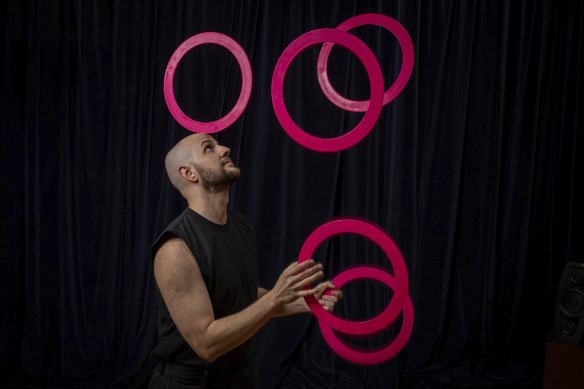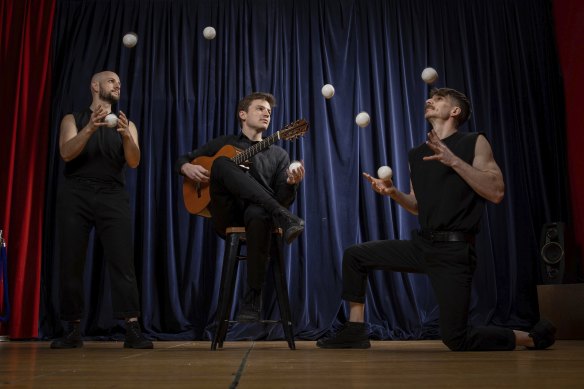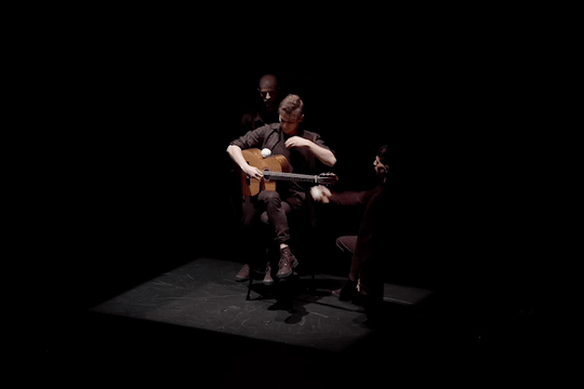This was published 9 months ago
Half sport, half art: Why juggling is more than a party trick
By Nell Geraets
The first time Byron Hutton tried juggling it was to distract himself. He was seven years old, and his grandfather had just died, so his father decided to lift his spirits by teaching him how to keep several balls in the air at once.
Juggling is generally thought of as a party trick used to distract, entertain, or amuse, but nothing much beyond that. However, the more Hutton practised, the more he realised that, for him, it wasn’t just a hobby.

Byron Hutton started juggling at the age of seven.Credit: Darrian Traynor
“I ended up treating it like a sport. I wanted to become the best possible juggler,” Hutton, who is now 32, says. “So, I would go to school, then catch a tram from school to a training space, and train until 6 or 7pm.”
His passion continued to grow as he was invited to perform at various conventions and festivals. By the age of 16, he was asked to be one of the main acts at a major New Zealand juggling convention. It was at that point that Hutton realised juggling was his future.
Since then, he has become one of the best in Australia, winning multiple awards, such as best circus award at the Adelaide Fringe Festival, and competitions, like the Gasworks Circus Showdown.
Most recently, he joined forces with fellow Melbourne-based circus performer Richard Sullivan and sound composer Samuel Kreusler. They created Escalate, a groundbreaking juggling performance that combines music and movement, which featured at the Melbourne Fringe Festival last year and is returning again this month. They are also preparing for a global tour, which will take them to the US, South America, Europe and Taiwan.

Escalate performers Byron Hutton, Samuel Kreusler and Richard Sullivan.Credit: Darrian Traynor
It wasn’t easy getting to this point. To date, Hutton says he has undergone over 20,000 hours of training. A five-second segment of a show could require two hours of practise, and an entire segment could take up to six months to develop.
“Juggling is a very slow thing to learn, especially with our work, which is so tightly choreographed. It’s not like we just have to learn five seconds of choreography. We’ve got to physically be able to do the skill within that five seconds, which often takes just as much time as learning the choreography.”
It’s also tough on the body. Hutton says he has to moisturise his hands multiple times a day, using the “strongest moisturiser money can buy”, to prevent his hands from cracking and bleeding. Though the balls are gentler on the hands, the rings and clubs damage them to the extent that he has to take a rest day between sessions to allow the skin barrier to recover. He also trains at the gym three or four times a week to strengthen his shoulders and back, two vital body parts for high-level jugglers.
For Hutton, it’s not just about simply being the best at juggling. He’s intent on revolutionising general perceptions of it, proving that it can be more than just a performance stunt.

Escalate’s use of sound in conjunction with juggling makes it particularly unique.
“Juggling has been a pretty stagnant art form. People have a certain idea of it set in their heads, which has made it difficult to sell shows in the past,” he says. “The most common place to see juggling is through busking. Buskers are incredibly talented, but there’s a system to it. Their job is mainly to talk to you, then show you one really impressive trick, and then ask for money. We’re bringing a new energy to the art form.”
This is what drives Escalate, a show that Hutton says took about three years to develop.
“In our show, every single throw and catch is planned. Every beat, every step is planned out. It’s a well-constructed piece of art, while being entertainment as well.”
What makes Escalate particularly unique is its use of sound in conjunction with juggling. Hutton notes one segment in particular, in which Kreusler plays a 45-second piece on a guitar five times over while Hutton and Sullivan gradually integrate their juggling into the rhythm. Eventually, Kreusler also begins juggling, while still playing the guitar.
“By the last loop, there are balls flying everywhere, but he’s still hitting every string perfectly,” Hutton says.
While juggling began merely as a distraction for him, Hutton hopes that young people will see shows like Escalate and be inspired to pick up their own juggling set, not just as something to whip out at a party, but as something to practice seriously, and to appreciate as a complex art-form.
“My generation was going through the woods of the unknown. I didn’t have a mentor growing up and YouTube was just getting started. The next generation of jugglers will have a lot more guidance. But I’m still pretty happy to be a trailblazer.”
Escalate is on at the Circus Oz Hub as part of the Melbourne Fringe Festival between October 9 and 20.
Find out the next TV, streaming series and movies to add to your must-sees. Get The Watchlist delivered every Thursday.